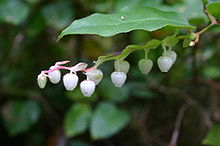Gaultheria
| Gaultheria | |
|---|---|

| |
| Gaultheria shallon | |
| Scientific classification | |
| Kingdom: | |
| (unranked): | |
| (unranked): | |
| (unranked): | |
| Order: | |
| Family: | |
| Genus: | Gaultheria
|
| Species | |
|
See text | |
Gaultheria is a genus of about 170-180 species of shrubs in the family Ericaceae. The name memorializes M. Hugues Gauthier of Quebec, a mis-spelt honour bestowed by the Scandinavian Pehr Kalm in 1748. These plants are native to Asia, North and South America, and Australasia. In the past, the Southern Hemisphere species were often treated in a separate genus Pernettya; however, there is no consistent reliable morphological or genetic difference to support recognition of two genera, and they are now united in the single genus Gaultheria.
The species vary from low, ground-hugging shrubs less than 10 cm tall, up to 2.5 m tall, or, in the case of G. fragrantissima from the Himalaya, even a small tree up to 5-6 m tall. The leaves are evergreen, alternate (opposite in G. oppositifolia from New Zealand), simple, and vary between species from 0.3-10 cm long; the margins are finely serrated or bristly in most species, but entire in some. The flowers are solitary or in racemes, bell-shaped, with a five-lobed corolla; flower colour ranges from white to pink to red. The fruit is a fleshy berry in many species, a dry capsule in some, with numerous small seeds.
- Selected species
|
|
Uses
Several species are grown as ornamental shrubs in gardens, particularly G. mucronata (Pernettya mucronata) from southern Chile and G. shallon (Salal) from the Pacific Northwest of North America. Many of the smaller species are suitable for rock gardens. Like most other ericaceous plants, gaultheria does best in a peaty soil that never fully dries out.
The fruit of many gaultherias is edible, particularly that of salal, which makes an excellent jelly. Wintergreen (Gaultheria procumbens) is the traditional source of wintergreen flavoring; its leaves can be used to make a tea, and its berries eaten as-is. The fruit of most other gaultheria species is insipid in flavour and not extensively consumed.
